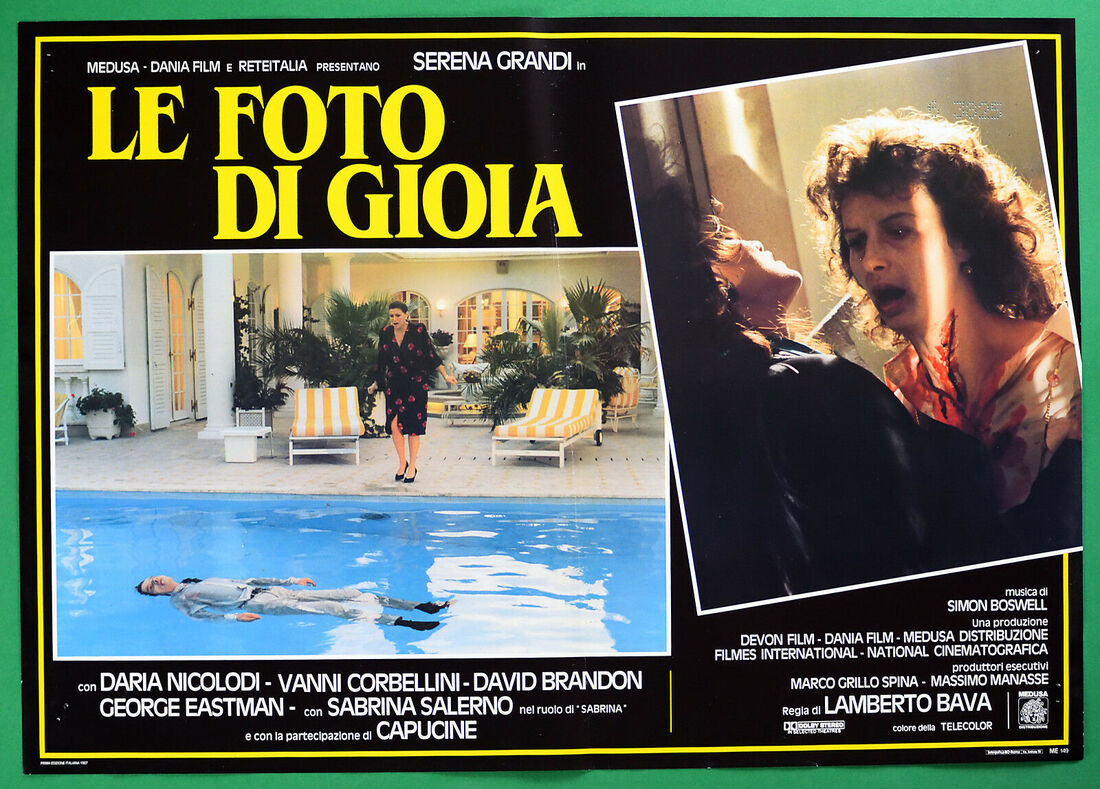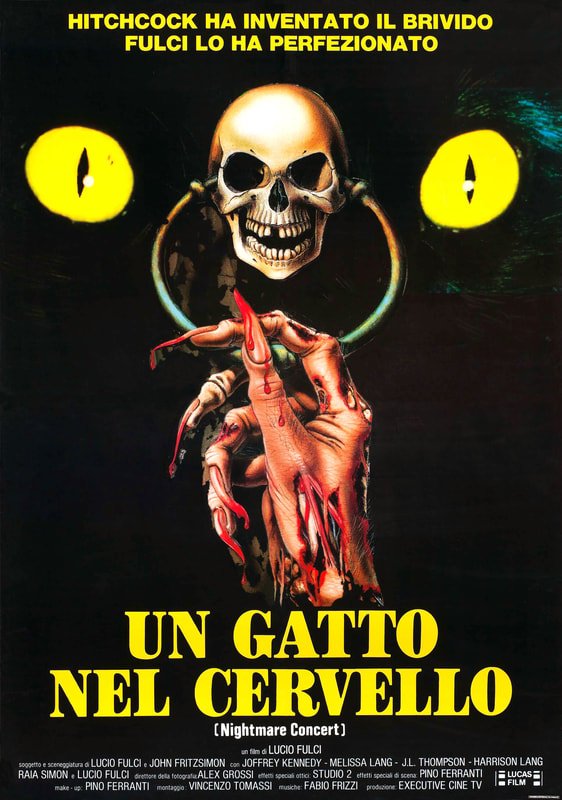Former model Gloria has inherited her dead husband's wealth, and spends her time helpfully expositing the circumstances of his death and running a nudie magazine. When models begin turning up dead, their corpses being photographed in a mysterious location in front of a giant snapshot of Gloria from her modelling days, it seems clear an obsession with her is the root cause. Is the killer trying to plant suspicion on Gloria, or are they trying to drive up sales of the magazine through publicity? Or are they doing the murders because of the most garbled, nonsensical bit of reasoning you've ever heard? (Yes.) Will Gloria escape alive, will the genre stalwarts George Eastman and Daria Nicolodi be given anything at all to do with their characters, and will Gloria's pervy peeping tom neighbour get his comeuppance for being a smarmy little sex pervert?
Well, no, he won't actually-he'll turn out to be the hero. But first things first. This film is in many ways a long, long way from the early examples of the genre (which was, of course, pretty much invented by Delirium director Lamberto Bava's father, Mario), but it could also be seen as a very 1980s updating of Blood and Black Lace. Consider the fashion house(ish) setting, the almost total absence of a logical A-B-C mystery (unlike The Girl Who Knew Too Much-excellent reference to the killer in that film's motive there), and the preponderance of pulsing colourful lights. However, Lamberto and Mario are very different directors. To be specific, Mario was an extremely skilled craftsman, capable of creating sumptuous and ingenious visuals on the skimpiest of budgets. Lamberto was not a skilled craftsman, but he could create some damn entertaining films. And this is one of the most entertaining of the lot.
One of the main 'innovations' of this film, and something which has been discussed at length before now, is the 'point-of-view' element to the early couple of murder scenes. Apart from a couple of brief instances this doesn't actually involve a POV camera, rather the general mise-en-scene morphs into a reflection of the killer's warped state of mind. The upshot is that we see the victims as a walking eyeball and bee respectively, lit by an expressionistic pulsing colour-changing light. The bee victim (played by Sabrina of 'Boys, Boys, Boys' fame) is clearly depicted as such because the killer is about to kill her with a load of bees, and the first victim-the walking eyeball-is presumably a hint at the scopophilic* subtext for anyone who's missed it.
The third murder scene (incorporating the third and fourth murders) dispenses with the subjective shenanigans, with both murders occurring offscreen. This, of course, should be an indicator to any serious giallohound that all may not be what it seems. Indeed, (SPOILERS!) the 'mystery' depends on us buying Gloria failing to notice that her brother isn't actually dead, merely made up to appear so. This is something which can work(ish) in literature (as Agatha Christie showed in one of her most famous works), but on film it's problematic. We, the audience, buy the apparent murder-after all, the makeup has been applied by the same makeup artist who's created all the other death effects in the film!-but in the world of the film it stretches credulity to breaking point to suggest that Gloria wouldn't notice that something's amiss. Saying that, there would be an undeniable shock to seeing a loved one apparently dead, so critical faculties might not necessarily be firing on all cylinders. Either way, we as the audience have no real way of telling, which makes it almost impossible to crack the case using deductive reasoning (something which this film also shared with B&BL). (END SPOILERS)
The film does use some classic misdirection/red herring-planting techniques. George Eastman, playing a scoundrel former lover of Gloria, is shown to repeatedly lie about his whereabouts, capped by a wonderful moment where we see him telling Gloria over the phone that he'll be back in Rome next Monday, with the Colosseum in full view behind him. There are also frequent cuts to Flora, Gloria's former mentor and current business rival, acting suspiciously right after evidence of the latest murder has surfaced. This is something I actually played with in a slightly different manner in my own giallo, cutting to a certain character after almost all of the murder scenes, making sure each time that she was behaving in a normal, unsuspicious manner. The idea was that the audience might notice and think that I was trying to sneak a link between the character and the murders past them, when in fact the character turns out to be innocent.
Lambava goes so far as to (SPOILERS) try to sneak a couple of cheeky references to the killer's guilt past the audience, with no double-bluffing involved. The killer-someone very close to Gloria who is instrumental in the day-to-day operations of her publishing empire-tells her after the latest model's death that "sales are booming," to which Gloria replies "They should-thanks to all the work you've done." Minutes later, after viewing the corpse of Beegirl (who he'd shagged right before she died), he muses aloud that he was "probably the last one to see her alive." The police detective, understandably not picking up on the fact that the killer is planting information for the film's audience to notice on a second viewing of the film, merely replies by saying "The last one? No. You're forgetting her killer." (END SPOILERS)
There are a few moments which suggest that the film is aware of the mild absurdity of its setting, with the struggle of a rich businesswoman to hang on to her publishing empire not exactly something to which we can all relate. A throwaway reference is made to Gloria's 'Ask Gloria' column in her mag being written by someone else, and the predatory competitor who keeps trying to buy Gloria out barks for an alcoholic loosener, to which her assistant replies: "Isn't is a little early to be drinking? It's not quite 9:30 yet." (This is 9:30am I hasten to add.) Another moment which is either knowingly filmic or showing an unthinking adherence to cliché comes when George Eastman mentions a proposition to Gloria in a bar, only for us to cut to the couple walking into her house, seamlessly picking up the conversation where they left off in the bar. This simply doesn't happen in real life, any is merely a tool used by films to expediently move characters from one location to another without disrupting the flow too much (although The Limey does experiment with this technique, to extremely interesting effect. However, that's one of the greatest films ever made; Delirium is not).
I've gotten this far without mentioning sex or nudity too much, for which I probably deserve a round, juicy medal. Delirium seems to have been conceived by producer Luciano Martino to showcase lead actress Serena's Grandis, although her acting ability is fairly minisculo. She even manages to persuade George Eastman to dispense with his trademark sex jeans (think Joe D'Amato's Caribbean films) for a bathtub romp, although he does seem to focus most of his attentions on the outside of her thigh. Being very much a product of a pre-MeToo era, in an un-MeToo country, the film's attitude towards women is predictably iffy. The first victim responds to a warning about going home alone from a party at Gloria's house ("You never know who you might run into") with a glib reply that could (one would hope) only have been written by a middle-aged man ("Just as long as he's cute"). The film is drenched with the sexual allure of the female body, with the killer's motive (although mostly garbled nonsense) stemming from his inability to deal with same. It's not unironic that a film which ostensibly judges a killer for his sexual perversions is simultaneously salivating over voluptuous female bodies (literally simultaneously when it comes to the film's climax [which features the killer being shot in the dick and splooshing blood all over Gloria's exposed body]).
The nosey neighbour, played by Colombian cyclist Rigoberto Uran (there's a niche reference for you) is clearly a take-off of Jimmy Stewart in Vertigo. His character is also someone to whom the progress of time and societal standards have not been kind. His pervy phone shtick is tolerated to a ridiculous degree by Gloria, and the fact that he's lonely and disabled hardly excuses his behaviour. In some ways it's refreshing to see a disabled character who's not the focus of the film's sympathy (nor is his disability used as a dubious justification for his being the murderer). However, (SPOILERS) his ultimate status as the 'hero' of the film leaves something of a sour taste, and I defy anyone to witness his shit-eating grin after vanquishing the murderer and not feel an intense urge to break his spine so the fucker really can't walk. (END SPOILERS.) Still, even when it's making you angry, the film is hard to hate. It's not a great giallo, or even a good one. It's not a good film by most metrics. But it sure as shit is mental (delirious) and guaranteed to entertain. Classic Lambava.
*For those of you who aren't wankers who studied English Literature or Film Studies at university, scopophilia is pleasure derived from observing/looking, usually of an erotic bent. Slasher films tend to be a rich ground for discourse on the subject, due to the frequent use of POV shots and nudie ladies, and her we also have the nosey neighbour and the general theme of photographing women for good measure.


 RSS Feed
RSS Feed
